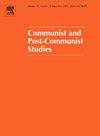遗产的发明
IF 1.3
4区 社会学
Q3 INTERNATIONAL RELATIONS
引用次数: 2
摘要
根据精英和大众调查,苏联后期的社会政治和经济秩序在很大程度上被认为是2022年前俄罗斯国内政治和经济现状的唯一可行选择。政治精英们投入了大量的精力和资金,通过不同的工具(包括电影摄影)审慎地促进了一系列思想遗产。这个被称为“好苏联”的综合体是一种想象中的社会政治和经济秩序,它在某种程度上类似于苏联后期的过去,但没有其固有的缺陷。为了维持政治经济现状,苏联遗留下来的元素被选择性地选择了出来。它们包括治理的等级机制、精英及其特权地位的低流通率、国家对媒体的控制以及对有组织的异议的镇压。与此同时,苏联后期的其他因素,如相对较低的不平等和某些国家社会保障,已被抛弃。一个“好的苏联”模式不仅包括市场经济和不短缺的商品和服务,而且还缺乏对寻租和精英财富和地位合法化的制度约束。在本文中,我们将“美好的苏联”视为过去社会建构的遗产,并通过使用现代俄罗斯电影技术和分析政治精英的政策偏好,重点关注将这一遗产转化为俄罗斯当前议程的机制。我们进一步考虑其对政治和决策的影响,以及其局限性和制约因素。结语部分讨论了苏联遗产对社会建设的一些启示。本文章由计算机程序翻译,如有差异,请以英文原文为准。
The Invention of Legacy
According to elite and mass surveys, the late-Soviet sociopolitical and economic order was largely perceived as the only viable alternative to domestic political and economic status quo in Russia before 2022. Political elites invested significant efforts and funds into deliberative promotion of a complex of ideational legacies through different tools (including cinematography). This complex, labeled a “Good Soviet Union,” is an imagined sociopolitical and economic order, which somehow resembles that of the late-Soviet past, while lacking its inherent flaws. Elements of the Soviet legacy were selectively chosen for the sake of preservation of the politico-economic status quo. They include the hierarchical mechanism of governance, low circulation of elites and their privileged status, state control over media, and repressions toward organized dissent. Meanwhile, other elements of the late-Soviet past, such as relatively low inequality and certain state social guarantees, have been discarded. A “Good Soviet Union” model includes not only market economy and no shortages of goods and services, but also a lack of institutional constraints on rent-seeking and legalization of wealth and status of elites. In this article, we consider a “Good Soviet Union” as a socially constructed legacy of the past and focus on mechanisms of translation of this legacy into Russia’s current agenda through the use of modern Russian cinematography and analysis of policy preferences on the part of political elites. We further consider its effects on politics and policy-making, as well as its limitations and constraints. Some implications of the social construction of Soviet legacies are discussed in the conclusion.
求助全文
通过发布文献求助,成功后即可免费获取论文全文。
去求助
来源期刊

Communist and Post-Communist Studies
Multiple-
CiteScore
1.90
自引率
0.00%
发文量
23
期刊介绍:
Communist and Post-Communist Studies is an international journal covering all communist and post-communist states and communist movements, including both their domestic policies and their international relations. It is focused on the analysis of historical as well as current developments in the communist and post-communist world, including ideology, economy and society. It also aims to provide comparative foci on a given subject by inviting comments of a comparative character from scholars specializing in the same subject matter but in different countries.
 求助内容:
求助内容: 应助结果提醒方式:
应助结果提醒方式:


